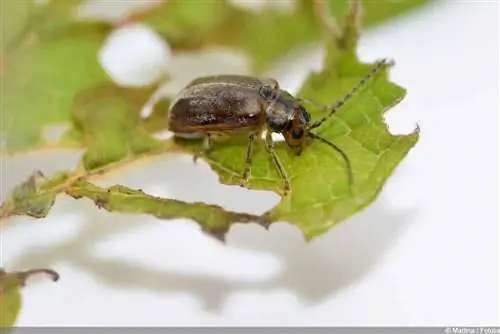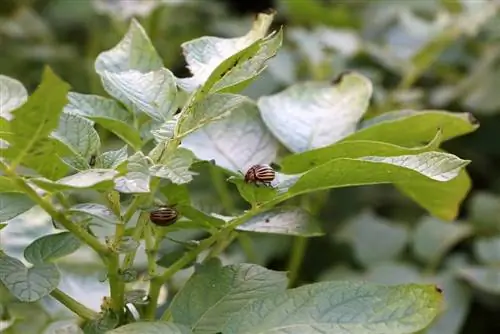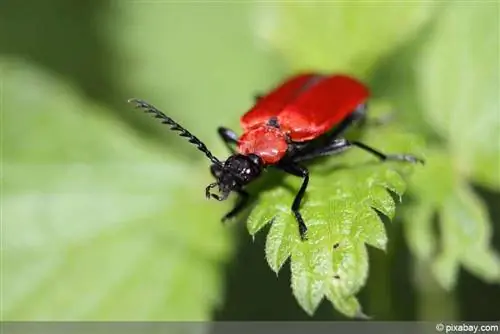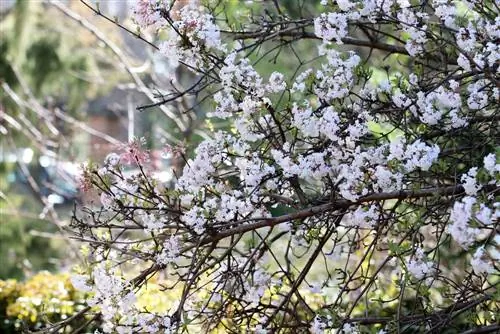- Author admin [email protected].
- Public 2023-12-17 03:39.
- Last modified 2025-01-24 12:45.
The common snowball has the botanical name Viburnum opulus and is a distinctive ornamental shrub. The plant got its name thanks to its snow-white inflorescences, which grow in a spherical shape. However, the various varieties of these ornamental shrubs are very susceptible to pests, especially the viburnum leaf beetle. This is known in science as Galerucella viburni and often causes great damage to the plant.
Viburnum Leaf Beetle
In their adult stage, snowball leaf beetles are only a few millimeters long, but they have a strong appetite. At the beginning of autumn, the female beetles drill deeper holes in the shoots and twigs in many places. They then lay their eggs there. Since each female can produce several hundred eggs, the damage caused is significant. The beetles then glue these holes together so that the offspring are well protected. In the following spring the voracious caterpillars hatch and cause the most damage to the ornamental plants.
- Beetles grow to a size of approx. 5-6 mm
- Elongated body is oval, with light brown coloring
- Reproduce from late September to early October
- When disturbed, beetles fall to the ground
- These then move on to another bush
- Beetles eat snowballs until the end of October
- Feeding marks lead to weakening of the plants
Larvae
In May, the voracious larvae hatch from the egg-laying sites in the shoots. These cause unsightly damage to the viburnum, which particularly affects the young leaves. If there is an extremely severe infestation, this can lead to the complete death of the affected plants. The larvae cause the greatest damage to the ornamental shrubs and should therefore be combated promptly.
- Size is about 6-9 mm
- Yellow-green colored with black spots
- Body has numerous warts
- Forms three pairs of legs in the chest area
- Pupates in the ground from the end of June, about 2-5 cm below the surface of the earth
- New population of beetles emerge from July to August
- Then the cycle continues again
Detect infestation
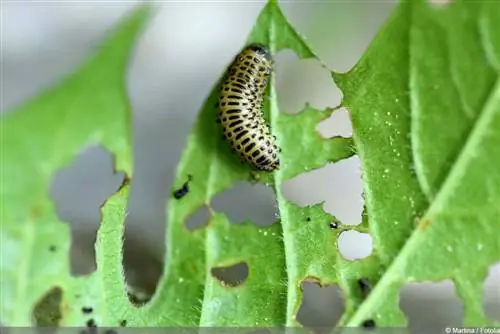
If the ornamental shrub has been attacked by the viburnum leaf beetle, this can be quickly recognized by the feeding spots. The leaves are particularly affected, but the holes in the shoots and branches are also a good indicator. An extremely severe infestation often leads to completely bare leaves and subsequent death of the plant. Once the pest has eaten its fill of the viburnum, it often moves on to other ornamental plants in the neighborhood.
- Check ornamental shrubs regularly for infestation
- Ideally remove the beetles before they lay their eggs
- In May, feeding damage caused by larvae is clearly visible
- Larvae eat the tissue between the leaf veins
- Leaves are often completely skeletonized
- Caterpillars are mainly found on the undersides of the leaves
- Remaining leaf tissue often turns brown
- Adult beetles visit the plants for the first time from July to August
- From autumn onwards, they drill holes in the annual shoots for laying eggs
- Egg laying sites are approx. 3 mm in size
Control measures
Infestation with the viburnum leaf beetle cannot be completely prevented, but it can be significantly reduced. It is always important to intervene promptly so that the pests do not develop into a plague and infect all ornamental plants in the garden. Chemical antidotes that are to be applied to the earth may not be used for private use. However, sprays against lice that are available from specialist retailers have proven to be effective. However, these should not be dangerous for bees as these beneficial insects feed on the viburnum flowers.
- Collect caterpillars by hand
- Lay out cloths on the ground under the plant
- Shake off and knock off pests
- Beetles are particularly active in the early morning
- In extreme cases, apply preparations containing pyrethrum
Prevention
The most suitable preventative measures include pruning. In this way, the nests can be permanently removed so that an infestation cannot occur in the first place. It also makes sense to attach barriers to the ornamental plant so that neither the caterpillars nor the beetles can move easily. This also makes it more difficult for the pests to migrate into the ground, where they pupate. If you till the ground under the ornamental shrub, you can destroy the pupae lying there. With appropriate fertilization, the ornamental plants can be strengthened and made more resistant to pests.
- Cut back young shoot tips in autumn
- Attach thicker glue rings
- Especially at the base of the trunk and around larger branches
- Dig up the soil under the bushes sufficiently in June to July
- Algae-based strengthening preparations available from specialist retailers
Soap & nettle broth

To prevent snowball leaf beetles from appearing, soft soap and nettle broth are suitable. These substances are not particularly popular with caterpillars either. The mixtures made from them are biologically harmless and gentle on the flora and fauna. This also drives away lice. It is important to have a certain continuity in the applications; these should be carried out on many days in short intervals.
- Dissolve soft soap in water
- Apply repeatedly to leaves, shoots and twigs
- Use from spring to autumn
- Make decoction from nettles
- Pour hot water over fresh nettle
- Let it steep for at least 24 hours
- Then filter out all solid components
- Spray the plant regularly with the solution
- Alternatively use sprays based on neem or rapeseed oil

